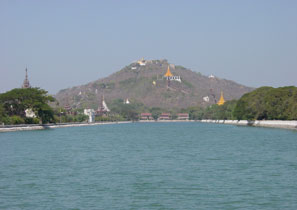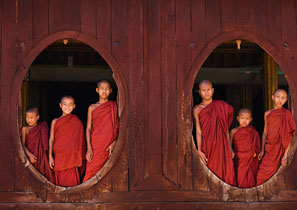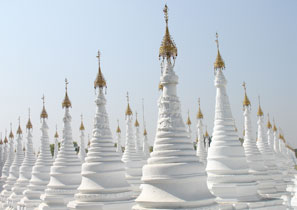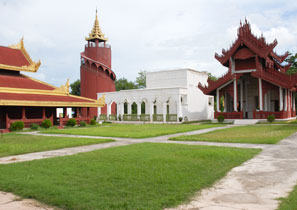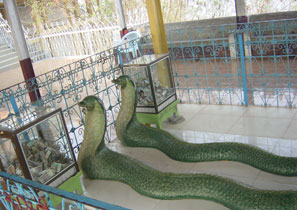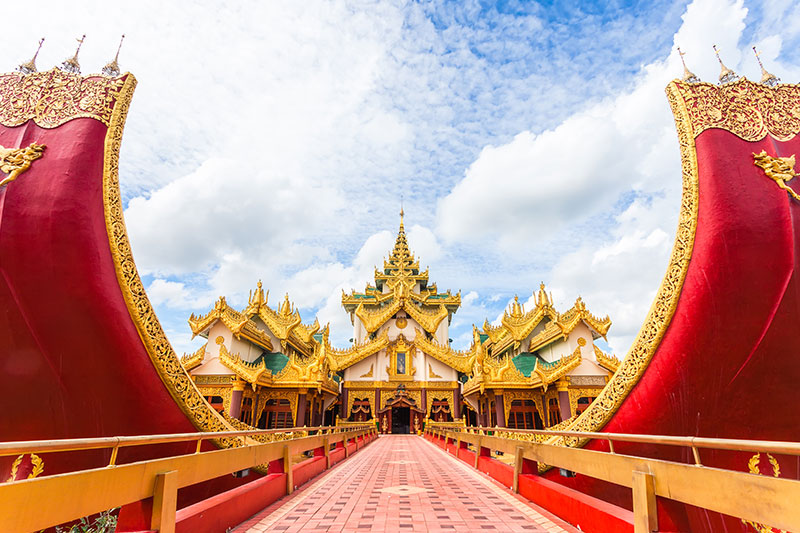
Mandalay
ABOUT MANDALAY
Seat of Ancient Kings
Nearby Mandalay Hill is crowned by a pagoda from which visitors can enjoy a 360-degree view of the city and surrounding countryside.
With its royal palace and impressive moat sitting at the foot of a high, pagoda-topped hill, Mandalay still evokes images of a romantic, bygone era. It remains the principal cultural and economic city of upper Myanmar. Located on the banks of the Ayeyarwady River, Mandalay also lies within easy striking distance of former colonial hill stations, ancient cities and other cultural attractions.
As the last seat of the Myanmar kings, Mandalay left a bittersweet legacy to the people. King Mindon of the Konbaung Dynasty, who reigned from 1853 to 1878, created this capital out of the wild woodlands at the foot of Mandalay Hill. King Mindon was a deeply religious monarch who made Mandalay and the neighbouring town of Sagaing important centres of Buddhism, with many great pagodas and hundreds of beautiful monasteries and nunneries.
The city’s notable attractions include Kuthodaw Pagoda, where Buddhist scriptures are carved on 729 marble tablets, billed as the “biggest book” in the world. One particularly beautiful legacy of Mindon is the all-teak pavilion he lived in just before his death, Golden Palace (Shwe Kyaung). Once completely gilded inside and out, only the interior gold remains undamaged. The rest of his palace was destroyed in World War II and a replica was built on the site. Nearby Mandalay Hill is crowned by a pagoda from which visitors can enjoy a 360-degree view of the city and surrounding countryside. Mahamuni Pagoda to the southwest of the palace holds one of Myanmar’s most revered Buddha images, a 4-metre-high statue covered with a thick layer of gold leaf applied by generations of pilgrims seeking merit.
Nearby Amarapura was once the seat of kings but now the best craftsmen of Myanmar work there embroidering tapestries, casting bronze, carving teak or weaving silk. Just outside of town is the 1.2-kilometre U Bein Bridge made of teak and spanning Taungthaman Lake. Inwa, just across the Myintge River from Amarapura, was another capital city, of which little remains but a handful of wellpreserved monasteries and a few segments of the old city walls peeking out from the tree roots and cultivated fields that have taken over the area.
A one-hour boat trip upriver from Mandalay – through the habitat of endangered Ayeyarwady dolphins – will take visitors to Mingun, the site of a huge, unfinished temple dating back to the 18th century. Had it been completed, it would have been the world’s biggest temple. The Mingun Bell is displayed in a nearby pavilion, believed to be the largest hanging, uncracked bell in the world.
Those seeking to escape the heat of the central plains need only travel 70 kilometres east of Mandalay, up a winding road to the old hill station of Pyin Oo Lwin. Although the main road through town serves as a busy trade route for trucks carrying goods to and from China, exploring the area’s back roads will reveal quaint Edwardian cottages dating back to the colonial era, as well as gardens where flowers, strawberries and even coffee beans are grown. Colourful horse carriages can be hired to visit beautiful National Kandawgyi Gardens, while those seeking exercise can hike forest paths to some of the natural waterfalls just outside of town.
HIGHLIGHTS
- Walk up Mandalay Hill, passing numerous shrines on the way to the pagoda at the top, which offers the reward of a spectacular view of the countryside beyond the city limits.
- Visit the Craftsmen’s Quarter to watch skilled artisans making silk fabric, gold leaf, marble statues, marionettes and embroidered tapestries.
- Explore the remnants of upper Myanmar’s ancient kingdoms by visiting Mandalay Palace and taking a tour of Inwa’s narrow country lanes by horse cart.
- Take a one-hour boat trip up the river from Mandalay to see the huge, unfinished pagoda at Mingun, keeping an eye out for elusive Ayeyarwady dolphins along the way.
- Spend a day or longer in the old hill station Pyin Oo Lwin, which offers colonial architecture, mountain scenery, cool temperatures and popular attractions like National Kandawgyi Gardens and Peik Chin Myaing Buddhist cave complex.


